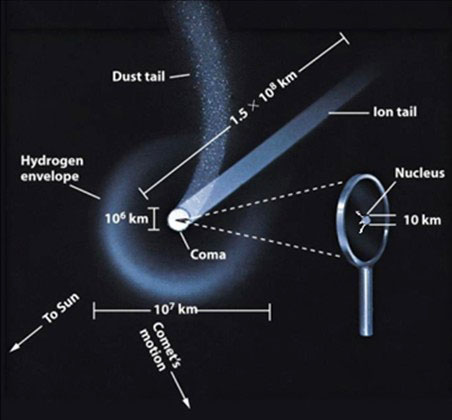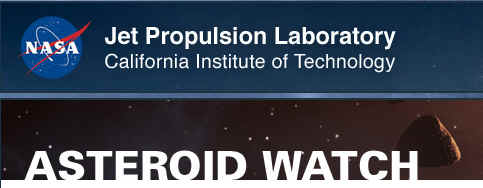
|
||||||||||||
|
|
|
Near-Earth Objects (NEOs)
Near-Earth Objects (NEOs) are comets and asteroids that have been nudged by the gravitational attraction of nearby planets into orbits that allow them to enter the Earth's neighborhood. Composed mostly of water ice with embedded dust particles, comets originally formed in the cold outer planetary system while most of the rocky asteroids formed in the warmer inner solar system between the orbits of Mars and Jupiter. The scientific interest in comets and asteroids is due largely to their status as the relatively unchanged remnant debris from the solar system formation process some 4.6 billion years ago. The giant outer planets (Jupiter, Saturn, Uranus, and Neptune) formed from an agglomeration of billions of comets and the left over bits and pieces from this formation process are the comets we see today. Likewise, today's asteroids are the bits and pieces left over from the initial agglomeration of the inner planets that include Mercury, Venus, Earth, and Mars.
Comet Structure As the primitive, leftover building blocks of the solar system formation process, comets and asteroids offer clues to the chemical mixture from which the planets formed some 4.6 billion years ago. If we wish to know the composition of the primordial mixture from which the planets formed, then we must determine the chemical constituents of the leftover debris from this formation process - the comets and asteroids. NEO Groups
In terms of orbital elements, NEOs are asteroids and comets with perihelion distance q less than 1.3 AU. Near-Earth Comets (NECs) are further restricted to include only short-period comets (i.e orbital period P less than 200 years). The vast majority of NEOs are asteroids, referred to as Near-Earth Asteroids (NEAs). NEAs are divided into groups (Aten, Apollo, Amor) according to their perihelion distance (q), aphelion distance (Q) and their semi-major axes (a).
What is a NEO? Near-Earth-Objects (NEOs) are small objects in the solar system (asteroids and short-period comets) with orbits that regularly bring them close to the Earth and which, therefore, are capable someday of striking our planet. Sometimes the term NEO is also used loosely to include all comets (not just short-period ones) that cross the Earth's orbit. Those NEOs with orbits that actually intersect the Earth's orbit are called Earth-Crossing-Objects (ECOs). What size NEOs are dangerous? The Earth's atmosphere protects us from most NEOs smaller than a modest office building (40 m diameter, or impact energy of about 3 megatons). From this size up to about 1 km diameter, an impacting NEO can do tremendous damage on a local scale. Above an energy of a million megatons (diameter about 2 km), an impact will produce severe environmental damage on a global scale. The probable consequence would be an "impact winter" with loss of crops worldwide and subsequent starvation and disease. Still larger impacts can cause mass extinctions, like the one that ended the age of the dinosaurs 65 million years ago (15 km diameter and about 100 million megatons). How many NEOs exist? There are many more small NEOs than large ones. Astronomers estimate that there are approximately 1100 Near Earth Asteroids (NEAs) larger than 1 km in diameter, and more than a million larger than 40 m in diameter (the approximate threshold for penetration through the Earth's atmosphere). The largest NEAs are less than 25 km in diameter. There are probably many more comets than NEAs, but they spend almost all of their lifetimes at great distances from the Sun and Earth, so that they contribute only about 10% to the census of larger objects that strike the Earth, and probably less than 1% of NEOs less than 1 km in diameter. Who is searching for NEOs? Several teams of astronomers worldwide are surveying the sky with electronic cameras to find NEOs, but the total effort involves fewer than 100 people. The most productive NEO survey is the LINEAR search program of the MIT Lincoln Lab, carried out in New Mexico with US Air Force and NASA support. The LINEAR team, which operates two search telescopes with one-meter aperture, discovers more asteroids than all the other searches combined. Other active survey groups include the NEAT search program in Hawaii, carried out jointly by the NASA Jet Propulsion Lab and the US Air Force; the Spacewatch survey at the University of Arizona, funded by NASA and a variety of private grants, the LONEOS survey at Lowell Observatory in Flagstaff Arizona, supported by NASA grants, and the Catalina Sky Survey in Tucson Arizona, also supported by NASA. Other astronomers (many of them amateurs) follow up the discoveries with supporting observations. Are any NEOs predicted to hit the Earth? As of the end of 2004, astronomers had discovered more than two thirds of the larger Near Earth Asteroids (diameter greater than 1 km). None of the known asteroids is a threat, but we have no way of predicting the next impact from an unknown object. What is the risk of impacts? We don't know when the next NEO impact will take place, but we can calculate the odds. Statistically, the greatest danger is from an NEO with about 1 million megatons energy (roughly 2 km in diameter). On average, one of these collides with the Earth once or twice per million years, producing a global catastrophe that would kill a substantial (but unknown) fraction of the Earth's human population. Reduced to personal terms, this means that you have about one chance in 40,000 of dying as a result of a collision. Such statistics are interesting, but they don't tell you, of course, when the next catastrophic impact will take placeónext year or a million years from now. The purpose of the Spaceguard Survey is not to improve these statistical estimates, but to find any individual rock that may be on a collision course. How much warning will we have? With so many of even the larger NEOs remaining undiscovered, the most likely warning today would be zero -- the first indication of a collision would be the flash of light and the shaking of the ground as it hit. In contrast, if the current surveys actually discover a NEO on a collision course, we would expect many decades of warning. Any NEO that is going to hit the Earth will swing near our planet many times before it hits, and it should be discovered by comprehensive sky searches like Spaceguard. In almost all cases, we will either have a long lead time or none at all. Is there a problem with blind spots in the Spaceguard Survey? Some press reports express concern that an asteroid could hit the Earth coming out of a "blind spot", such as the daylight sky or high southern latitudes where no Spaceguard telescopes are looking. Some worry that if an asteroid is found after its closest approach to Earth, this is an indication that the system is not working. These concerns seem to be based on the misconception that we are trying to detect asteroids as they approach the Earth on their final plunge toward impact. In fact, any such last-minute warning system is impractical as well as unproductive. In this survey, it makes no difference if a NEA is discovered on approach or departure from the vicinity of the Earth. The important thing is that it is discovered and its orbit determined. The only effect of blind spots, whether they be due to sunlight or moonlight or bad weather or lack of a southern hemisphere survey telescope, is to slow down the completion of the NEA catalog. Objects in blind spots will be picked up later, usually within a few years, in a more favorable geometry. How can we protect ourselves? NEO impacts are the only major natural hazard that we can effectively protect ourselves against, by deflecting (or destroying) the NEO before it hits the Earth. The first step in any program of planetary defense is to find the NEOs; we can't protect against something we don't know exists. We also need a long warning time, at least a decade, to send spacecraft to intercept the object and deflect it. Many defensive schemes have been studied in a preliminary way, but none in detail. In the absence of active defense, warning of the time and place of an impact would at least allow us to store food and supplies and to evacuate regions near ground zero where damage would be the greatest. What is the government doing about it? The US Congress held hearings to investigate the impact hazard in 1993, 1998, and 2002, and both NASA and the US Air Force are supporting surveys to discover NEOs. In 1998 NASA formally initiated the Spaceguard Survey by adopting the objective of finding 90% of the NEAs larger than 1 km diameter within the next decade (that is, before the end of 2008). In 1998 NASA also created a NEO Program Office, and today $3-4 million per year is being spent on NASA-supported NEO searches and orbit calculations. Other governments have expressed concern about the NEO hazard, but none has yet funded any extensive surveys or related defense research. A private Spaceguard Foundation based in Europe promotes NEO surveys internationally, and further interest on an international basis is provided by the International Astronomical Union, the International Council of Scientific Unions, and the United Nations. What about smaller, more frequent impacts? The Spaceguard Survey and most associated search and tracking programs are concentrating on NEAs larger than 1 km in diameter -- large enough to risk a global ecological catastrophe if one of them hit the Earth. But there are many more smaller undiscovered NEAs, and we are likely to be hit somewhere on Earth by one of these, with an energy equivalent to a large nuclear bomb, sometime in the next couple of centuries. The last such impact was in 1908 in Tunguska ( Siberia ) with an estimated explosive energy of 15 megatons. The actual risk to each of us from Tunguska-like impacts is very small -- much less than the risk of larger impacts, and indeed much less than the risk from many common natural hazards, such as earthquakes and severe storms. Nevertheless, there are people who are interested in this problem. In 2003 NASA completed a study of these sub-km impacts and concluded that it was both technically feasible and cost-effective to to mount an expanded Spaceguard Survey, with much larger telescopes, to search for these smaller asteroids. Potentially Hazardous Asteroids (PHAs) are space rocks larger than approximately 100m that can come closer to Earth than 0.05 AU. None of the known PHAs is on a collision course with our planet, although astronomers are finding new ones all the time. NASA's Jet Propulsion Laboratory is introducing a new Web site that will provide a centralized resource for information on near-Earth objects - those asteroids and comets that can approach Earth. Click on the logo below to visit the site-
The B612 is a non-profit organization founded by a group of astronauts and scientists whose goal is to predict and prevent catastrophic asteroid impacts on Earth. B612 aims to find potentially threatening asteroids, track their trajectories, and to demonstrate the technology to alter the orbit of an asteroid in a controlled manner.
Credit: NASA, B612 Foundation |







